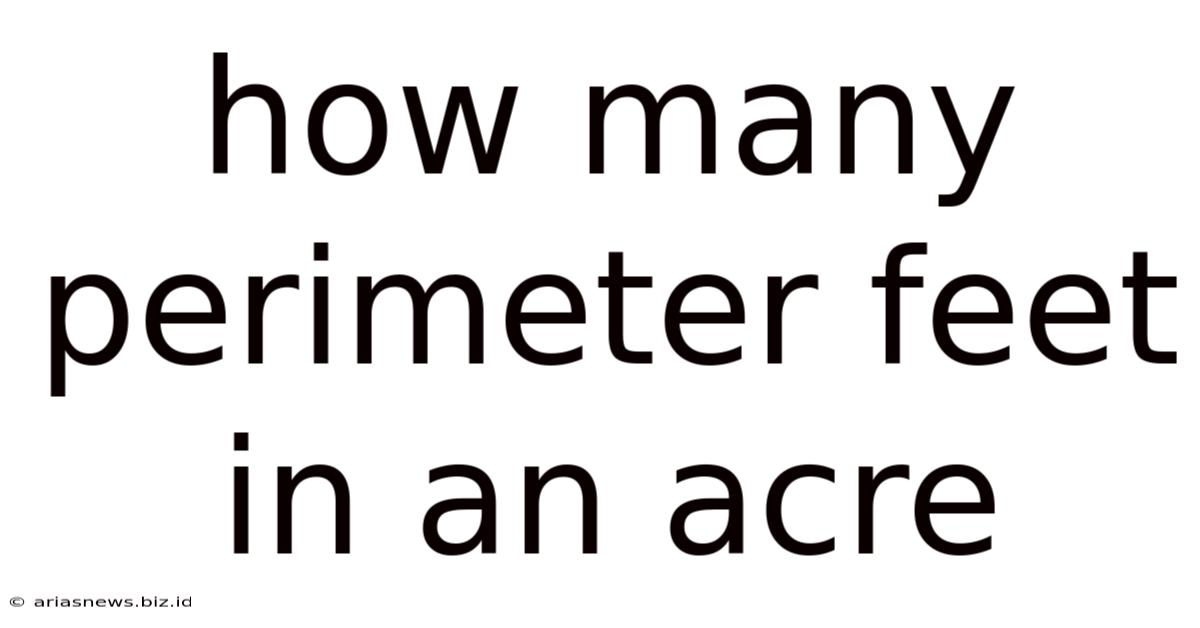How Many Perimeter Feet In An Acre
Arias News
May 10, 2025 · 4 min read

Table of Contents
How Many Perimeter Feet in an Acre? It's Complicated!
Determining the perimeter of an acre isn't as straightforward as calculating its area. Unlike area, which is consistently 43,560 square feet, the perimeter of an acre is highly variable and depends entirely on the shape of the land. This article delves into the complexities of this question, exploring various shapes, calculations, and practical considerations. We’ll also touch on the importance of understanding perimeter in land surveying, real estate, and other fields.
Understanding Acreage and Perimeter
Before diving into the calculations, let's clarify the basics:
-
Acre: A unit of land area equal to 43,560 square feet. This is a standard measurement used worldwide for land parcels.
-
Perimeter: The total distance around the outside of a shape. For a rectangle, it's twice the sum of its length and width; for a circle, it's the circumference. For irregular shapes, it requires more complex calculations.
The key takeaway is that there's no single answer to "how many perimeter feet are in an acre?". The perimeter depends entirely on the shape of the one-acre plot.
Calculating Perimeter for Different Shapes
Let's explore the perimeter calculations for several common shapes that could represent a one-acre plot:
1. Square Acre
A square is the simplest shape to analyze. To find the side length of a square acre, we take the square root of the area:
√43,560 sq ft ≈ 208.71 ft
The perimeter of a square acre would then be:
4 * 208.71 ft = 834.84 feet
This represents the minimum perimeter possible for a one-acre plot. Any other shape will have a larger perimeter.
2. Rectangular Acre
Rectangular plots are very common. The perimeter calculation for a rectangle is:
Perimeter = 2 * (Length + Width)
To find the perimeter, we need to know both length and width. However, we can explore different length/width combinations that yield an area of 43,560 square feet. For example:
- Length = 217.8 ft, Width = 200 ft: Perimeter = 2 * (217.8 + 200) = 835.6 feet
- Length = 300 ft, Width = 145.2 ft: Perimeter = 2 * (300 + 145.2) = 890.4 feet
As you can see, even with rectangular shapes, the perimeter varies significantly.
3. Circular Acre
A circular one-acre plot is less common, but it’s helpful for illustrating the concept. The area of a circle is πr², where 'r' is the radius. To find the radius of a circular acre:
πr² = 43,560 sq ft r² = 43,560 sq ft / π r ≈ 117.75 ft
The circumference (perimeter) of a circle is 2πr:
Circumference ≈ 2 * π * 117.75 ft ≈ 739.35 feet
Notice that the circular acre has a smaller perimeter than many rectangular options, highlighting how shape significantly impacts the perimeter.
4. Irregular Shaped Acre
Many real-world acre plots have irregular shapes. Calculating the perimeter of an irregular shape requires more advanced techniques. Often, surveyors use measuring tools and software to determine the exact perimeter by breaking the plot into smaller, manageable sections and calculating the distance of each section.
Practical Implications of Perimeter
Understanding the perimeter of an acre is crucial in several practical applications:
- Fencing: The perimeter determines the amount of fencing required to enclose the land. This directly impacts the cost of materials and labor.
- Land Surveying: Accurate perimeter measurement is essential for boundary demarcation and property disputes.
- Real Estate: The perimeter can influence property value and desirability. A longer perimeter might mean more frontage on a road or access to water, increasing value.
- Construction: Knowing the perimeter aids in planning building placement, infrastructure development, and landscaping.
- Agriculture: Perimeter is relevant for planning field layouts, irrigation systems, and crop management.
Factors Affecting Perimeter Calculation
Several factors can complicate perimeter calculation beyond the basic shape:
- Terrain: Uneven land makes accurate measurement challenging. Slopes and elevation changes must be considered.
- Obstacles: Existing structures, trees, or other obstacles affect the usable perimeter and may necessitate adjustments in planning.
- Legal Boundaries: Property lines might not perfectly align with geometric shapes, leading to irregular perimeters.
- Measurement Accuracy: The precision of measuring tools influences the accuracy of perimeter calculations.
Conclusion: No Single Answer, but Critical Understanding
There's no single answer to how many perimeter feet are in an acre. The perimeter varies widely depending on the shape of the land. Understanding this variability is key. For simple shapes like squares and rectangles, calculations are straightforward. However, for irregular shapes, advanced techniques and tools are necessary. Ultimately, comprehending the relationship between area and perimeter is crucial for various applications, from practical projects to real estate transactions and beyond. Remember to always consult with qualified professionals like surveyors for precise measurements, especially when dealing with real-world property boundaries. The significance of accurate perimeter calculation cannot be overstated in various aspects of land management and development.
Latest Posts
Latest Posts
-
If You Re Born In 1993 How Old Are You
May 10, 2025
-
How Much Is 64 Ounces In A Gallon
May 10, 2025
-
How Long Does It Take To Get To Michigan
May 10, 2025
-
Horse Of Different Color Wizard Of Oz
May 10, 2025
-
Given Pqrs What Is The Measure Of Q
May 10, 2025
Related Post
Thank you for visiting our website which covers about How Many Perimeter Feet In An Acre . We hope the information provided has been useful to you. Feel free to contact us if you have any questions or need further assistance. See you next time and don't miss to bookmark.